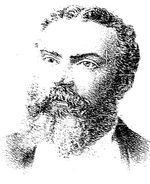Signatories of the Banco de San Luis Potosí
Gerente
|
He was managing director of the San Luis Potosí branch of the Banco Nacional Mexicano from its opening on 31 October 1882El Siglo Diez y Nueve, 14 November 1882 and continued in this role when the banks fused to form the Banco Nacional de MéxicoEl Siglo Diez y Nueve, 15 July 1884 until 1 December 1884El Tiempo, 28 December 1884. He was then put in charge of the bank’s new branch in Chihuahua, where he had to contend with the problem that most of that state’s existing banknotes were based on copper, rather than silverEl Album de la Mujer, Año 3o, Tomo 4o, Núm. 6, 8 February 1885. In early 1887 he was back in San Luis Potosí as the manager of the new branch of the Banco de Londres y Sud-América, which opened on 1 MayThe Two Republics, 19 May 1887. By May 1890 he was inspector of all the Banco de Londres y Sud-América’s branchesEl Siglo Diez y Nueve, 26 May 1890. From 1883 Wastall was also involved in trying to establish a supply of drinking water for the city, spending $45,000 of his own money on proposals and plansEl Mundo, Tomo VI, Núm. 914, 21 March 1899 and, after various set-backs, finally signing a contract with the state government on behalf of an English company. He was director gerente of the Banco de San Luis Potosí from its founding until his death on 15 March 1899El Estandarte, 17 March 1899; El Popular, 19 March 1899; El Correo Español, 21 March 1899. He was succeeded by Antonio Fernández Noval. Wastall signed the bank's first notes, with dates up to 10 June 1899 (after his death). |
 |
|
Antonio Fernández Noval was a member of the Spanish colony in San Luis Potosí. He was appointed manager in May 1899El Continente Americano, 3 May 1899. He signed notes dated from 10 January 1898 and continued to be manager until the bank was liquidated. He died in 1934. |
 |
Consejero
|
He had investments in a group of mining companies in the centre and north of the countryHe was a shareholder in El Cabezón y Anexas, S.A. (Ojo Caliente, Zacatecas); Compañía Minera San Luis de Conformes y Anexas, S.A. (Pinos. Zacatecas); Compañía Minera de Angustias (Pozos. Guanajuato). Negociación de la Mina de Nuestra Señora del Refugio y Socavón de la Luz (Real de Catorce); the haciendas de beneficio de la Luz and Palmarito; the ranchos of San Elías and Buena Vista and the orchards of Mujica and Buquebal. He was a shareholder and member of the board of the Compañía Minera La Constitución; Compañía Minera La Guadalupana y Anexas (Moctezuma), Compañía Minera Tiro General de Charcas (Charcas); Compañía Minera Fe en el Trabajo (Real de Catorce); Compañía Minera Protección al Trabajo (Real de Catorce) and the Compañía Minera Explotadora de la Veta Madre en Guanajuato, S.A. (Guanajuato).. He also held shares in industry (Compañía Industrial Cervecería de San Luis) and was involved in urban development and civil engineering (Compañía Constructora del Camino Carretero del Puerto de Tampico). He was a Juez del Supremo Tribunal in 1867, jurado de sentencia, regidor of the town council of San Luis Potosí on several occasions from 1864 to 1896 and a deputy to the XIII Legislature from 1889 to 1891. He was President from the founding of the bank in 1897 until his death in San Luis Potosí on 13 March 1907. He had previously been on the local board of the Banco Nacional Mexicano and was later one of the concessionaires for the Banco de Guanajutofurther infomation in Juan Carlos Mendoza Martínez, Matías Hernández Soberón: familia y política en San Luis Potosí, 1864 – 1894, San Luis Potosí, February 2015. |
 |
|
Guillermo R. Peterson was on the board as primer vocal from 1897 until 1903. In 1903 he had to resign when the company J. H. Bahnsen y Compañía went into bankruptcy, causing a run on the bank. He was also a consejero and signed notes for the Banco de Aguascalientes. |
 |
|
Tomás Olavarría Olivares was segundo vocal from 1897 to 1903, primero vocal from 1904 to 1907, Vice-President from 1908 to 1915, and finally President in 1916. Tomás Olavarría was born in October 1851 at Gordexola in the Basque region of Spain and was a relative of Jacobo Olavarría (a merchant and non-formal lender). In 1884 his merchant house (Tomás Olavarría y Compañía) was wound up and he joined the brothers Enrique and Daniel Aresti to found the company Enrique Aresti y Hermano. A year later Enrique returned to Bilbao where he continued to invest in a wide range of important companies in his home county, such as railway, mining, and metallurgical and paper companies. Daniel Aresti, who was four years younger than his brother, remained in San Luis Potosí in charge of the business together with Tomás Olavarría as manager under the name of Aresti y Compañía. Olavarría participated in the public canteen project in 1892 when a drought affected corn production in the state and caused a serious problem of famine. On his initiative, a board was formed chaired by Matías Hernández Soberón, which was in charge of collecting monthly donations to feed tortillas, chickpeas, rice and meat to more than three hundred people daily, for more than seven months. Olavarría invested in the San Luis Potosí to Tampico Railroad and had shares in the La Preferencia mine. He died in Mexico City circa 1932. He signed notes dated from 1897 through to 1913. |
 |
|
Eduardo Meade was Vice-President from 1897 till 1907 and then President until 1915. The Meade family had come to Mexico from Ireland in the first half of the 19th century and developed interests in agriculture and mining. The firm Hermanos Meade, registered as “Casa de Federico J. y Eduardo Meade. Comerciantes, banqueros y comisionistas” was established in 1867. Eduardo held 4.4% of the bank's shares. He also had shares in the Banco de Guanajuato and 14% of the Banco de Aguascalientes. In addition he was a shareholder and president of the Compañía Minera La Candelaria y Anexas in Pinos in 1891 and a shareholder in several other mining companies including the Compañía Minera Providencia del Oro (San Pedro, 1893); Compañía Minera Anónima de Urista y Anexas (Noria de Angeles, 1893); Compañía Minera El Nuevo Potosí y Anexas, S. A. (Guadalcazar, 1893), Negociación Minera Santa María de la Paz (Matehuala, 1894); Compañía Minera San Fernando y Anexas, S. A. (1895); Compañía Minera Anónima Santa Fe y Anexas (Matahuala, 1896); Compañía Minera El Rescate y Anexas, S. A. (Vetagrande, 1896); Compañía Minera del Refugio en Guadalcazar, S. A. (Guadalcazar, 1901) and Compañía Minera Potosina de Minas de Cobre (Charcas, 1906). |
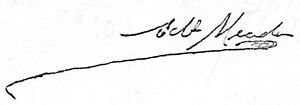 |
|
Gerardo married Joaquina Sainz Trápaga. She inherited from her father, Angel Sainz Trápaga the Hacienda del NaranJo, that covered land in the three neighbouring states of Tamaulipas, San Luis Potosi and Veracruz. He signed notes dated 1903. |
|
|
Mariano Hernández Ceballos was a cousin of Matías Hernández Soberón, and a mining investor and banker. He was a regidor for San Luis Potosí in 1899El Contemporaneo, 12 December 1898, 1902El Contemporaneo, 26 December 1901, 1903El Tiempo, 1 January 1903 and 1904El Comtemporaneo, 4 January 1904. In 1900 he acquired the Hacienda de Guanamé, in the municipio of Venado, which he used for breeding bulls. In March 1900 he was elected to the board of the bank, in substitution for Manuel Rivero Soberón who had gone back to SpainEl Correo Español, 7 March 1900. He was tercero vocal from 1900 to 1903, segundo vocal from 1904 to 1907, primer vocal from 1908 to 1915 and Vice-President in 1916. He was also one of the concessionaires for the Banco de Aguascalientes on 29 April 1902. He owned 224 shares (4.48%) in the Banco de Guanajuato and 7% of the Banco de Aguascalientes. He signed notes dated from 1900 to 1911. |
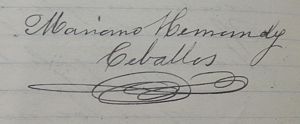 |
|
Eugenio Labarthe Meade was born in 1877, in San Luis Potosí, the son of Celestino Labarthe Setiey, who was cajero of the branch of the Banco Mercantil Mexicano until 1882Periódico Oficial, 27 November 1882 and of Matilde Meade Lewis. He was segundo vocal from 1908 to 1915 and primer vocal in 1916. While a boardmember he continued to have his own business, promoted as “Eugenio Labarthe, S. en C. Banqueros, Exportadores y Comisionistas”. Labarthe signed notes dated from 1911 to 1913. |
 |
Interventor
|
J. Teofilo Fonseca was an attorney (abogado) who by 1911 could claim forty years of public serviceDiario Oficial, 23 October 1911. He was working for the Ministro de Hacienda in 1876El Siglo Diez y Nueve, 9 September 1876, was jefe de la Sección 2ª in 1879La Patria, Año III, Núm. 742, 28 October 1879, jefe de la Sección 6ª in 1896La Patria, 23 October 1896 and Contador de segunda clase en la Contaduría Mayor de Hacienda in 1899El Tiempo, 30 May 1899. He signed notes dated 1897 to 1900. |
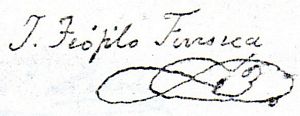 |
|
In August 1896 Lara applied for a patent for a new type of canteen that he had inventedLa Voz de México, 26 August 1896 and in July 1898 he was granted copyright for his “Caramañola Lara” by the Mexican government for twenty yearsSemanario Oficial, Morelos, 17 December 1898. On 31 August 1901 while he was in Saltillo as interventor for the Banco de Coahuila, Lara applied for a US Patent, which was granted on 13 May 1902 (US699697A) for a period of seventeen years. Lara took over as interventor on 27 February 1899informe of interventor Lara, 10 July 1899 in Memorias de las Instituciones de Crédito correspondientes a los años 1897-1898-1899. He signed some $100 and $500 notes dated 1900. |
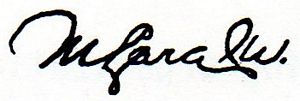 |
|
Enrique Baz was appointed interventor in October 1900CEHM, Fondo CDLIV Colección José Y. Limantour, 2a. 1900, carpeta 4, legajo 15680. He served until 21 June 1901, when he moved to take up the position of interventor of the Banco de Guanajuatoinforme of interventor Baz, 31 August 1901 in Memorias de las Instituciones de Crédito correspondientes a los años 1900-1902. He signed notes dated 1901. |
 |
|
Juan J. Farías’s parents owned the Hacienda de Bocas, situated 40 kilometres north of San Luis Potosí, and in his youth he managed the hacienda on their behalf. However, the hacienda passed into the hands of Jesús García in 1900. Perhaps in anticipation in August 1897 Farías had the governor of San Luis Potosí, Carlos Díez Gutiérrez, ask Limantour to appoint him Interventor of the proposed Banco de San Luis PotosíCEHM, Fondo CDLIV Colección José Y. Limantour, 1a. 1883, carpeta 20, legajo 5222 and in September Farías had his parents’ friend, General Bernardo Reyes, governor of Nuevo León, write to Limantour with the same requestCEHM, Fondo CDLIV Colección José Y. Limantour, 1a. 1883, carpeta 43, legajo 11318. Farías was unsuccessful but was appointed Interventor of the Banco de Guanajuato in August 1900. He signed notes dated from 1901 to 1903. |
 |
|
Luis G. Camacho had been interventor of the Banco de Nuevo León. Camacho took over as Interventor on 7 July 1904Memoria de las Instituciones de Crédito correspondiente a los años de 1904-1906, vol. I, tomo 1. He signed notes dated from 1909 to 1913. |
 |

